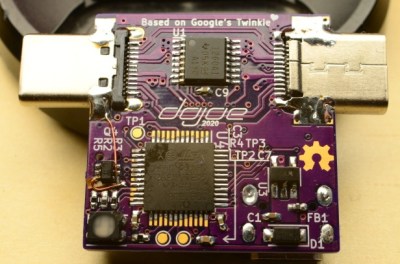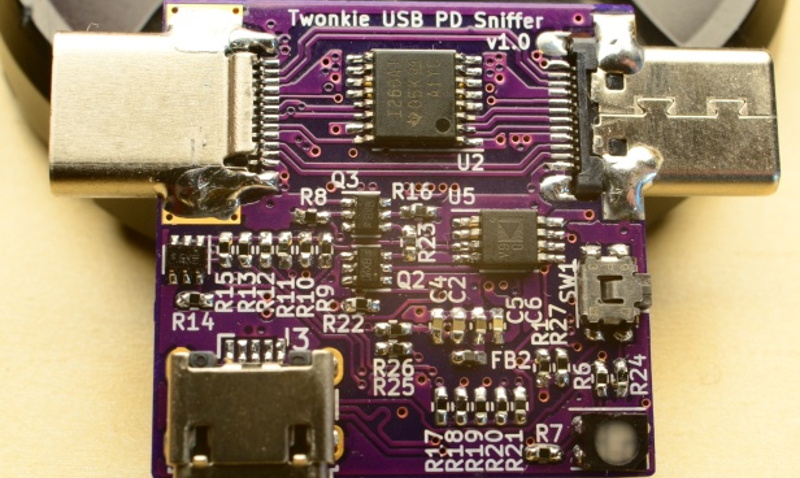If you want to hack around with the communication protocol that USB Power Delivery devices use to negotiate their power requirements with the upstream source, a tool like Google’s Twinkie really helps. With it you can sniff data off the line, analyze it, and even inject your own packets. Luckily for us, the search giant made the device open source so we can all have one of our own.
Unfortunately, as [dojoe] found out, the Twinkie isn’t particularly well suited for small-scale hobbyist manufacturing. So he came up with a revised design he calls Twonkie that replaces the six layer PCB with a much more reasonable four layer version that can be manufactured cheaply by OSHPark, and swaps out the BGA components with QFP alternatives you can hand solder.
 That said, it’s still likely to be a challenging build for the home gamer. There’s quite a few 0402 passives on there, and while those are doable with an iron, it can certainly be tricky. To take some pressure off, [dojoe] says he tried to optimize the board layout as much as possible for hand assembly. He was even able to avoid needing hot air by straddling the PCB with USB-C mounts intended for vertical applications.
That said, it’s still likely to be a challenging build for the home gamer. There’s quite a few 0402 passives on there, and while those are doable with an iron, it can certainly be tricky. To take some pressure off, [dojoe] says he tried to optimize the board layout as much as possible for hand assembly. He was even able to avoid needing hot air by straddling the PCB with USB-C mounts intended for vertical applications.
Given the current chip shortage, [dojoe] says the biggest problem might actually getting your hands on the STM32F072CB microcontroller at the Twonkie’s core. To that end, the board supports TQFP44 and QFN44 footprints, and you can even use a STM32F072C8 at the cost of some functionality. With a bit of luck, hopefully you can find a chip that will work in the parts bin.















Would be cool if you could replace the micro usb with the same usb-c plug. This would reduce the amount of different components on the bom
“If you want to hack around with the communication protocol that USB Power Delivery devices use to negotiate their power requirements with the upstream source”
Interesting, you’d think they’d use networked PDUs.
Definitely looks like this is pushing the definition of “hand solderable”, but I appreciate that he took the 6(!) layer design and made it into something we can actually get manufactured. Sort of an interesting thought experiment there: should manufacturability be a consideration in open hardware? How open is it really if only a company has the ability to make their own?
Then again, if it wasn’t open, [dojoe] wouldn’t have been able to respin it into something he could actually build…
It might not be an requirement, as you point out given the ability to respin, but I’d say that a good open hardware *project* definitely should consider manufacturing. Reminds me of when I was involved in the OSVR HDK, I remember responding with some degree of surprise at the 6 layer board, though having the schematic public at least was helpful a few times.
Probably a more critical point for open hardware is obtainable parts: the challenge with the hdk2 (and anything with a display, generally) was the hdmi bridge chip: hard to get on its own without a vendor relationship, and impossible to get the same version with the built in hdcp keys (grr). On the other hand, the Project North Star AR HMD has managed to arrange group buys of the LCD panels and driver boards, which cam typically be a challenge, so even that isn’t a fatal flaw.
It is certainly pushing the boundaries but is possible – I built both my prototypes entirely by hand and while some cussing was involved it was not usually related to the 0402 passives :)
I will say though that this is the first design where my usual mantra of “tip size doesn’t matter” no longer applies. A good and relatively fine tip does go a long way – but in a pinch some extra flux is a good substitute.
“hopefully you can find a chip that will work in the parts bin.”
A 1.5EUR bluepill should do the job?
Not the same part unfortunately. The Twinkie firmware uses several hardware components of the F072, most notably the fast analog comparators, and the F103 doesn’t have those.
I would like to make a Twonkie enclosure. Is the Gerber available?
Certainly: https://github.com/dojoe/Twonkie/tree/master/hw/v1.0
When you’re done, I would be delighted about a pull request and photos :)
I dropped $300 on the Total Phase twinkie board, only to realize about a week later that it will be obsolete when 28V USB-PD devices arrive start shipping later this year. Live and learn…
Does this look like a suitable replacement USB-PD sniffer?
https://www.digikey.com/en/products/detail/cypress-semiconductor-corp/CY4500/6159169